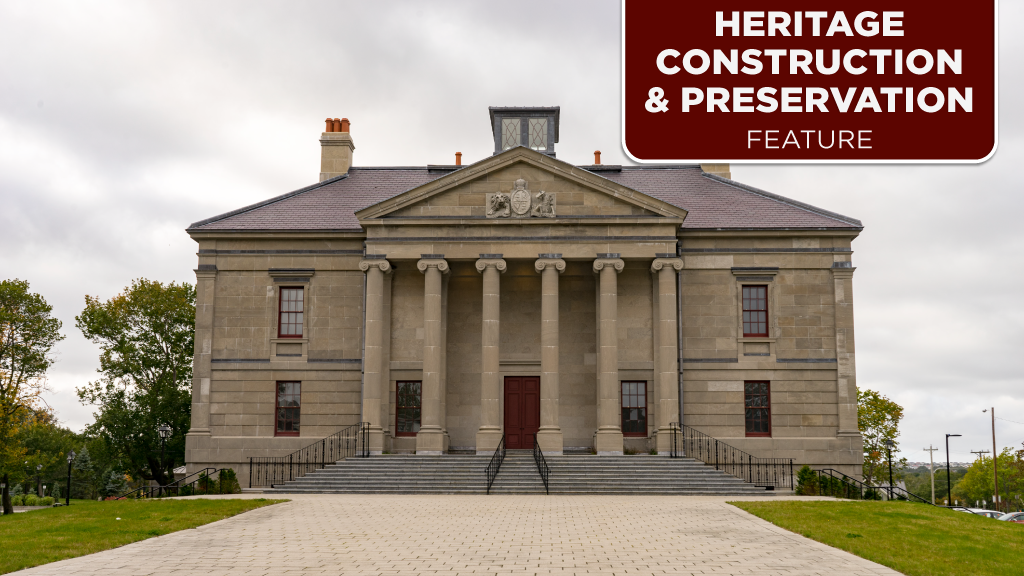Before decorative painter/faux finisher Lori Le Mare commenced period-appropriate finishes this year at the restoration of Newfoundland’s first legislative building in St. John’s, she put on her detective’s hat to “identify the process and the hand of the person” who created the original finishes.
No easy task. The Colonial Building – the province’s seat of government until 1959 – is 172 years old.
But the six-month fast-paced job, which includes the restoration of two large ceiling murals, is gratifying work for Le Mare, owner of Hamilton-based Lori Le Mare Studio Inc.
Her contract, part of a $22-million transformation of the building into a museum, includes getting the color, sheen and design of the original paintings, a challenge where water has damaged, discolored and/or detached paint. Her crew of seven is also creating finishes of faux sienna marble, faux grey and pink granite, faux Venetian plaster, 23-karat gold gilding and faux quarter sawn oak wood-graining on windows, doors, wainscoting and trim.
At the outset, matching paint colors by eye in the poorly-lit interior (before proper lighting was installed) proved tricky. Spotlights helped but in some areas the best solution was to color-match the paint outdoors in the sun with original paint flakes taken from the ceiling.
While the timeline for the contract’s completion at the end of September is tight, Le Mare and her crew have had to take days off in summer because of high heat and inadequate ventilation. Humidity has thwarted work progress some days, causing water-borne glazing products to weep as though the “walls were crying,” Le Mare says. “We found a fan and just kept working the glaze with our brushes until it started to dry and stay intact.”
Calling the job her largest requiring a match of the new reveals to the originals, Le Mare says she has worked on numerous high-profile historic projects in Canada and abroad. In the field since 1989, she has experience at a castle in the Loire Valley, France, Toronto’s Casa Loma, the Aga Khan Museum and Dundurn Castle in Hamilton. She has also taught and worked in Italy, the U.S., Spain and China.
While the job, like many of her projects, has novel challenges, even before it commenced she faced hurdles. When the RFP was issued last November, Le Mare only had a couple of weeks to digest all the documents and price the job while continuing her work on another complex contract.
“The challenge then was to find capable people to leave their lives (in and around Hamilton) for six months with only a month’s notice.”
“The people I chose I already knew. Some I used to work with years ago in Toronto, some had taken my classes years ago and were involved in heritage work and all are extremely talented artists in their own right.”
The relationship between Le Mare’s team and Redwood Construction, overseeing the project, has been “terrific,” she says, noting that Redwood has prepared all the surfaces and put up “very efficient scaffolding,” to improve working conditions and eliminate the need for her crew to wear safety harnesses at ceiling heights.
The job has also been made “easier and healthier” because heritage consultant Jablonski Building Conservation, Inc. of New York permitted the use of contemporary products. On some jobs she is required to create finishes mixing original formulas. Glaze, for example, has been made by hand using turpentine, raw linseed oil and dryers. “I have even used beer to recreate water-borne finishes as the (original) artisan would have done.”
The contract has been not only been rewarding but educational for Le Mare and her team. “We’ve learned a lot about the island, its culture and history.”
It has also provided a few adventures for the crew. “To be working on something one loves to do and afterward go whale watching, hiking and making art from found beach objects is wonderful. It’s been a dream to be here.”











Recent Comments
comments for this post are closed